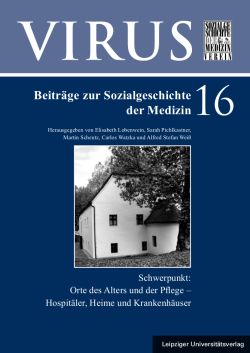Elke Schlenkrich
S. 127 - 139
doi:
10.1553/virus16s127
doi:
10.1553/virus16s127
Abstract:
This article highlights ‘enclosed’ facilities caring for the poor and the sick in Leipzig – the St. Georg and the St. Johannis Hospitals as well as the Plague Lazaretto. It traces long-standing traditions reaching from the Early Modern Period to the 19th century. In this context, it outlines development processes that led to a differentiated medical and nursing care landscape. The Johannis Hospital, for example, became an elderly care facility. The Lazaretto, which was originally built to receive people infected with the plague, sowed the seeds for a modern hospital. At the same time, these micro-historical investigations demonstrate that the processes of differentiation and profile shaping going on within the care landscape of Leipzig involved the exclusion of previous facility occupant groups.
Saxony, Leipzig, medical history, history of hospitals, history of patients, Early Modern Period, 19th century, microhistory, historical anthropology
Published Online:
2020/07/22 20:56:28
Object Identifier:
0xc1aa5576 0x003bb5c9
Rights:https://creativecommons.org/licenses/by/4.0/
Die Zeitschrift "Virus - Beiträge zur Sozialgeschichte der Medizin" ist das Publikationsorgan des Vereins für Sozialgeschichte der Medizin und erscheint einmal jährlich.
Sie versammelt wissenschaftliche Beiträge verschiedener Disziplinen, die sich mit Themen aus den Bereichen Medizin, Gesundheit und Krankheit in historischer, kultur- und/oder sozialwissenschaftlicher Perspektive empirisch auseinandersetzen. Weitergehende Einschränkungen für Beitragsvorschläge in thematischer oder methodischer Hinsicht bestehen nicht.
Der "Virus" publiziert vornehmlich Beiträge mit Bezug zur Geschichte der Medizin in Österreich, dessen Nachbarländern sowie der ehemaligen Habsburgermonarchie. Vergleichend angelegte Arbeiten können aber über diesen Rahmen auch hinausgreifen. Hinsichtlich der behandelten Zeiträume bestehen keine Eingrenzungen, jedoch stehen Beiträge zur Medizin in der Neuzeit und der Moderne/Postmoderne im Vordergrund (16.-21. Jahrhundert).
…




 Home
Home Print
Print
 References
References
 Share
Share
